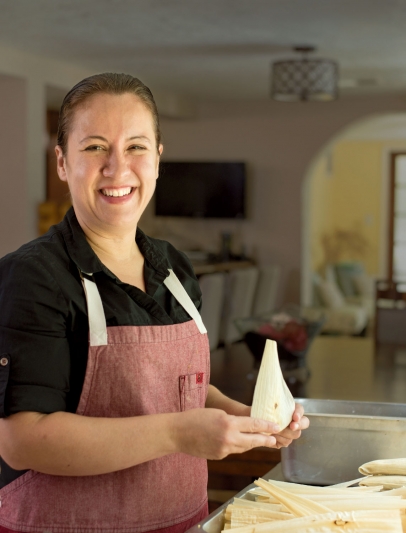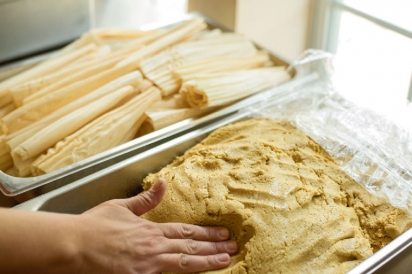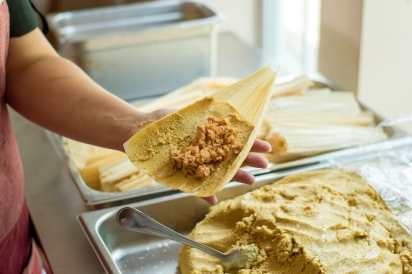From Scratch Tamales -- The Sum of Local Parts
Let’s Talk Tamales
Any chef will tell you: season everything! That’s how Arlene Morales makes tamales. The self-taught catering chef soaks and grinds her own dried yellow or blue corn kernels; she renders her own lard, which she flavors with a clove or two of garlic, maybe even a bay leaf or dried chili. Lard is, after all, what binds the ground corn into a smooth corn dough, that masa. She braises pork in green chili, stews beef with chipotle, or chicken with habanero for a good kick.
“You’re missing an opportunity to add flavor to your overall result if you don’t season half of your dish: season the lard, season the masa—it all adds to the flavor!”
Making tamales—good, delicious tamales—she felt was an excellent way for people to get to know her and her food and build her catering business, Geo’s Catering. She started three years ago and is now a weekly vendor at three farmers markets, with two more in the planning.
Growing up in Honduras, she grew up with tamales and knew what she was looking for in terms of taste and consistency: that distinct taste of corn, and a dough that was neither crumbly nor dry. It’s what motivated her to say, “Right, I am going to do this myself.”
Honduran tamales are big and rather like a complete meal, with a stuffing that includes vegetables, potatoes and raisins, for instance, in addition to meat. Typically, they are wrapped in banana leaf, not dried corn husks. “Plantains and yucca are our main starch. We don’t eat that much corn,” she explained. Morales’ tamales are basically a blend of two styles of Mexican tamales that she liked. “I like the size of the tamales from Mexico City and I like the northern-style ratio of meat to masa. With my tamales, we meet in the middle: a good amount of meat, and small in size.”
Morales works from a local restaurant’s commercial kitchen, which she can use either late at night, after dinner service is done, or at dawn, before the restaurant fires up again. She does get help sometimes, from family and friends. But mostly, she cranks out 60 dozen tamales each week all by herself.
To make tamales, Morales begins with sorting through the corn (yellow or blue) which she then soaks in water with an alkaline solution. In Honduras, she would take the soaked corn to a village mill. Here, she uses a hand-cranked corn grinder to muscle the soaked corn into a mushy pulp. The next step is done by a pastry machine: mixing the corn with lard into a dough. Finding the balance is part of the process: not so soft that they crumble when you bite into them, not too dry, not too wet.
“The easiest way to get masa soft is to put in fat, and more fat. But you end up with tamales that drip with fat.” To get the masa fluffy, you need to incorporate air—and that means kneading. “The more you knead the masa, the fluffier it gets.”
In Morales’ food philosophy, the sum of all components is only as good as the thought given to each one. That includes sourcing: “I don’t want to grab just any meat from the refrigerator bin. Like I said, working on one and neglecting the other doesn’t add up for me. So, I searched for a local rancher and Felix Florez (Black Hill Ranch) popped up.” She looked him up and sent him a message. Soon, she was loading pork butts and back fat to render lard into her truck. “He’s the one who introduced me to the whole market idea. I had no idea how to start, and he got me started,” said Morales. “If I owe the success to anyone, it is Felix [Florez].”
For Florez, supporting Morales is a no-brainer. “I mean, she takes something we Texans eat every day, only she makes it way better,” he said, although that is only part of the reason why he loves what she does. “These days so many people cut corners, not many people out there want to go the extra mile. Arlene does. She’s not motivated by money, a quick buck or an easy market. I will always do what I can to support people like her.”
As her catering business grows, the shared commercial kitchen is not a sustainable situation in the long run. She needs her own space and is considering various options, including a shipping container converted to a kitchen with a commercial license parked in her own yard. What she’d really like, what she dreams about, is a commercial kitchen with a retail front.
“Like the tortillerias around here [East End]. They have a commercial kitchen in the back, and then counter service on the weekends where people can pick them up to take home, or eat right there. Not a restaurant. Not at this point. I don’t have commercial line experience. I am taking my first baby steps here in this industry, and I’m already figuring out that finding good labor is difficult. I had a lady come in two days, and then she quit: too much hard work,” she laughs. One thing Morales is not considering, is a food truck, saying she’s too much of a wimp. “It would be so, so hot. And then steaming those tamales … no thanks!”
To add to the challenge, Morales also regularly works with blue corn, in addition to yellow corn. Price aside (blue corn is double the price of yellow corn, or $1.50 versus $.70 per pound), blue corn yields a different consistency. It gets softer faster, and it holds a lot more moisture when you grind it, making it hard to get the masa the right consistency. One market day, Morales forgot to write “blue corn” on the wrapped tamales. A lady who bought some called her after three days: She had kept them in the fridge but wondered if they were still good. They smelled good, she said, but … they were blue!










